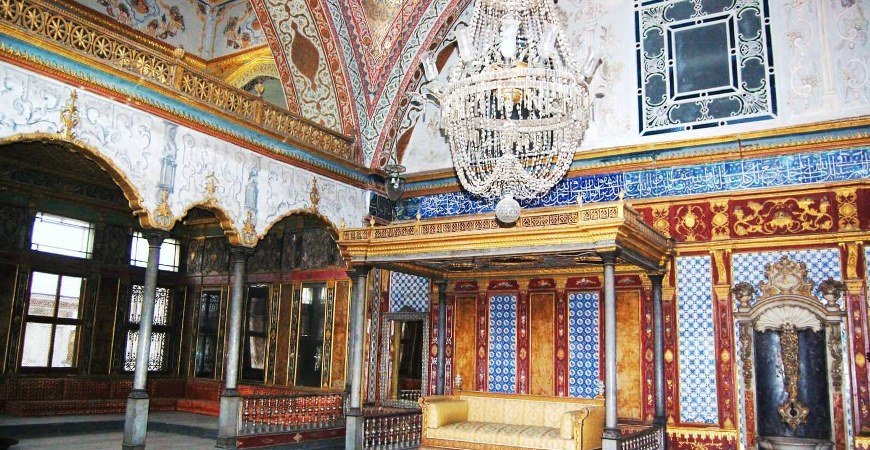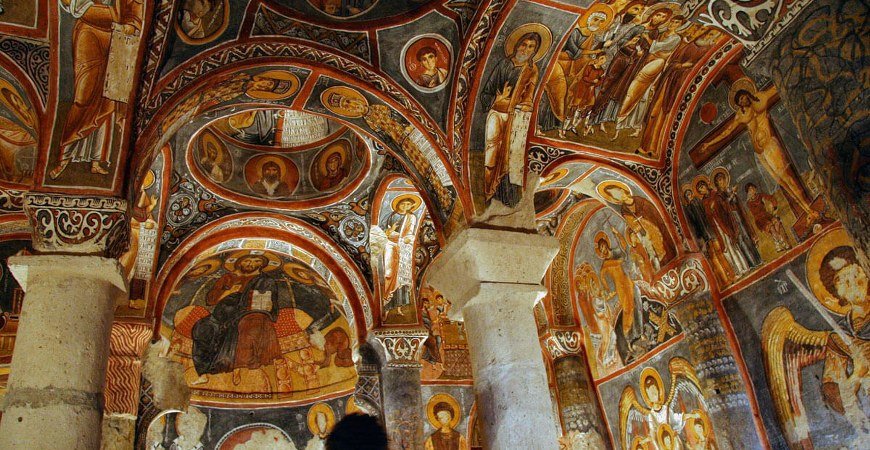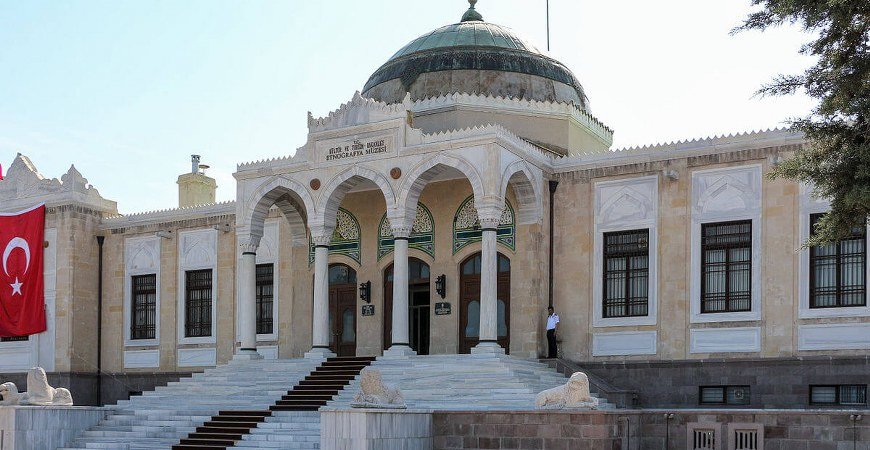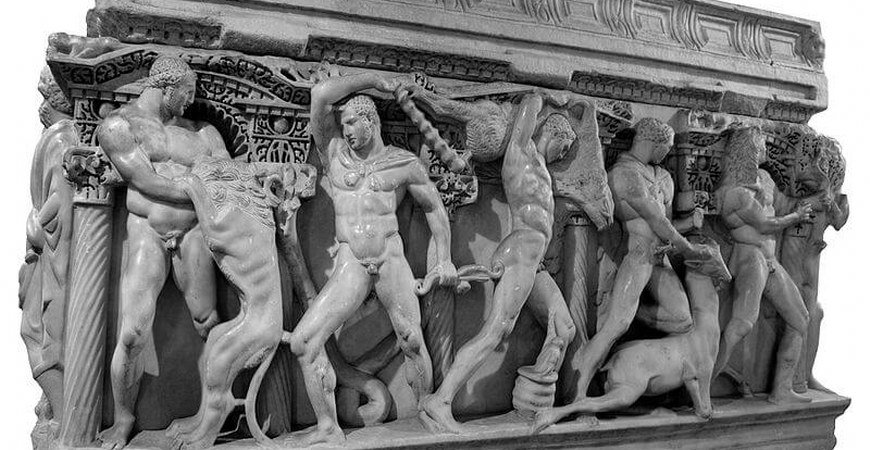Author: erkan

The Emerald Dagger In Topkapi Palace Museum Istanbul – Chapter 2
The Emerald Dagger In Topkapi Palace Museum Istanbul – Chapter 2,
The Ottoman Sultan Mahmud the First also sent a delegation, led by Kesriyeli Ahmed Pasha, with gifts to Nadir Shah, which set out on May 11, 1747. Among the gifts which the Sultan sent to Nadir Shah was a dagger whose hilt and sheath were ornamented with precious stones. This dagger had been made by Istanbul’s master Jewel-smiths under the direction of the treasurer, the precious stones being provided from the Treasury. The two delegations met near Baghdad, showed their gifts to each other with a special ceremony, and then went on their ways, the Iranians to Baghdad and the Turkish delegation to Hamedan. When the Turkish delegation arrived at the Iranian border the news came that Nadir Shah had been killed in his headquarters in Fechabad. Nothing could be done. The leader of the delegation Ahmed Pasha decided to turn back in order to save the treasures from being plundered. After a thousand and one difficulties they, at last, arrived back at the Ottoman border without any of the gifts having been lost or damaged. Upon arriving in Istanbul they were handed over to the Palace. Meanwhile, the Iranian delegation had arrived in Baghdad. They requested asylum from the Ottoman state and were accepted. All the gifts which they carried were considered to be Ottoman property and were handed over to the Treasury. The Emerald Dagger in Topkapi Palace Treasury today, which was shown in the film ‘Topkapi’, is one of the gifts which were sent to Nadir Shah. The Dagger is 35 cm. in length, and has three huge emeralds as big as pigeons’ eggs on one side of the hill, ‘which is how it came to be known as the Emerald Dagger. The emeralds are encircled by diamonds and at the end of the hilt is an eight sided Emerald lid, which when opened reveals a small watch. The rest of the hilt is ornamented with enameling and diamonds. The sheath is as beautiful, being decorated with enameled flowers, and brilliant diamonds. At the tip of the slightly twisted sheath is a huge emerald. There are other dangers in Topkapi Palace Treasury of as great value and beauty as the Emerald Dagger. Among these is the crystal handled dagger of Yavuz Sultan Selim, and another ‘whose owner is unknown, whose hilt is made of a single piece of emerald with a gold sheath decorated with diamonds. Each one is a priceless masterpiece of Turkish jewel smithery. However, none has ‘won the game of the Emerald Dagger which was the subject of the film. Every day thousands of visitors come to Topkapi Palace. They queue up in front of the glass case in the second room of the Treasury which houses the Emerald Dagger. They are determined not to miss seeing it. In the market places and shops, copies of the Dagger are there for those who want them, as souvenirs of the beautiful city of Istanbul.

The Emerald Dagger In Topkapi Palace Museum – Chapter 1
The Emerald Dagger In Topkapi Palace Museum – Chapter 1,
In 1964 an American film called ‘Topkapi’ was shown all over the world. The story of this film took place in Istanbul: A gang smuggling antiquities plan to steal the Emerald Dagger worth millions from Topkapi Palace. In the end with the aid of the measures taken at Topkapi to prevent antiquities being stolen, and the admirable efforts of the Turkish police the members of the gang are caught and the Emerald Dagger put back in its place. The film ‘Topkapi’ was shown in almost every cinema in the world, making Topkapi Palace and the Emerald Dagger famous all over the world. Foreigners coming to Istanbul wanted above all to see the Emerald Dagger. Picture postcards depicting the Dagger and cheap imitations were the most popular of the souvenirs sold on the streets of Istanbul. The world’s largest tourist and travel agencies printed posters showing the dagger, and the Emerald Dagger became the most famous of all the treasures and masterpieces of Topkapi Palace. When was the Emerald Dagger made? How did it get to Topkapi Palace? Is it really valuable? To answer these questions we first have to relate the following story: There was once an Oguz Turk from Avsar called Nadir Han, who defeated the Safevi dynasty and took over the Iranian throne under the name Nadir Shah and proceeded to make great conquests. First, he led a campaign against the Timurogullari in India. He conquered their capital city of Delhi and carried off all the legendary Indian treasures to Iran. Among these treasures was the famous Keykavus Throne which is now in Topkapi Palace and now known as the Nadir Shah Throne. He extended his campaign to Turkistan and the Caucasus and then decided to establish friendly relations with the Ottomans. An agreement was signed between the two states, and Nadir Shah entrusted the task of taking many valuable gifts to the Ottoman Sultan Mahmud the First to two of his trusted men of the state, Sanli Mustafa Han, and Mehmed Mehdi Han. Among these gifts was the Keykavus Throne from among the treasures found in Delhi.
You can continue to find more details about The Emerald Dagger In Topkapi Palace Museum Istanbul in Chapter 2.

Nadir Shah’s Throne In Istanbul Topkapi Palace Museum – Chapter 3
Nadir Shah’s Throne In Istanbul Topkapi Palace Museum – Chapter 3,
Today in the third room of the Treasury in Topkapi Palace is exhibited an Indian made throne which dazzles the eyes. This throne, which was known for many years as the Shah Ismail Throne, is now known to be none other than the Keykavus Throne which Nadir Shah sent as a gift to the Ottoman Sultan Mahmud the First in 1747. Studies of the throne on the basis of documented evidence were only recently carried out, proving that this throne was, in fact, that of Nadir Shah which was brought to the Treasury in 1758, and not that which Yavuz Sultan Selim took from Shah Ismail. The throne is a masterpiece of painstaking work by Indian craftsmen. It rests on 4 feet, its edges being in the form of a raised table. At the front is a low chair on which to rest the feet, and on the seat of the throne is a cushion decorated with gold thread and pearls. The entire surface of the throne is covered with gold, ornamented with red and green enamel and decorated with rubies, emeralds, and pearls. There are many other thrones in Topkapi Palace Museum. For example the Arife Throne (Eve Throne) of Sultan Ahmed the First decorated with mother of pearl and precious stones, the Bayram Throne (Festival Throne) made in the 18th Century from solid gold and decorated with 955 topaz, the War Throne made in the 17th Century and ornamented with ivory and mother of pearl, and the Gold Domed Throne, made in the 16th Century and now exhibited in the Arz Room. But all eyes are on the Nadir Shah Throne, a throne of unparalleled beauty which is visited by thousands of visitors every day, who gaze at it in wonder and admiration. Please note that Topkapi Palace Museum is open every day all year round except Tuesday.

Cappadocia Goreme Open Air Museum Churches
Cappadocia Goreme Open Air Museum Churches,
Church Of The Apple (Elmali Kilise)
This church was carved into the rock at the right side of the road passed the Girl’s convent while going to the region of Churches. A dome was placed over four pillars. It has one big and two small apses. Although the frescoes of the Iconoclastic Age remained clean, some broken and separated parts can be seen. On the walls, there are pictures symbolizing the sanctification of Jesus inside the dome and the baptizing of Jesus, his migration to Jerusalem, the Last Supper, the crucifixion and treachery of one of the Apostles, named Judas. Because a round form, seen in the hand of Jesus Christ appears in one of the pictures on the wall, resembles an apple, this church was called The Church of the Apple”. But according to some researchers, this form actually symbolizes the earth.
Dark Church (Karanlik Kilise)
It is one of the churches with a dome made of four pillars. It has a big apsis and two small ones on each side. It is one of the most beautiful churches built in the 11th century. The paintings are still lively and the colors have not faded because of very little sunlight penetrated inside. It only has a small window giving on the outside. Because of this the church is gloomy and was named “Dark Church”… The facts related in the Gospel were represented beautifully by pictures on the walls of this church. The sanctification of Jesus, the last supper.
Three Kings giving presents to Jesus, his help to sinful people, his baptism and crucifixion, the treachery of Judas, one of the Apostles, the figures of Mark and John and of the Apostles are frescoes attracting attention to the dome.
The Church With The Shoes (Carikli Kilise)
Although its frescoes are damaged in parts, the picture showing Christ is in good condition and because of the shoe prints visible at the bottom of the picture, it has been called Carikli Kilise (the Church with the Shoes). Carikli is a kind of mocassin. Other frescoes include scenes from Christ’s Birth, Crucifixion, and one showing Abraham’s hospitality.

Nadir Shah’s Throne In Topkapi Palace Museum – Chapter 2
Nadir Shah’s Throne In Topkapi Palace Museum – Chapter 2,
Nadir Shah chose to send the famous Keykavus Throne which he had brought back from Delhi and entrusting it to Mehmed Mandi Han and Sanli Mustafa Han the throne was sent to the Ottoman Sultan Mahmud the First along with many other gifts. The caravan carrying the boxes filled with gifts set out for Istanbul. For Nadir Shah, Sultan Mahmud the First had a dagger ornamented with huge emeralds and rubies made. Besides this, he had several loads of treasures made ready and sent them to Iran. The envoys of Nadir Shah and the Sultan set off and met near Baghdad on May 30, 1747. With a special ceremony they showed each other the gifts they were carrying and a few days later they went their separate ways. Just as the Ottoman delegation reached the city of Hemedan, there was a large uprising in Iran. Nadir Shah was captured and put to death as he tried to escape from the headquarters in Fethabad. There was only one thing that the Ottoman delegation could do, that was to turn around and go back to Istanbul taking their gifts with them. After great difficulties, they reached the Ottoman border without any of the treasures being plundered and delivered all the gifts to the Ottoman treasury. The Iran envoy learned of the uprising and Nadir Shah’s death while In Baghdad. Mehmed Mehdi Han was Nadir Han’s most trusted official and for him to return to Iran meant certain death. So he chose to seek asylum from the Ottomans. This request was accepted in a note sent to Baghdad in which it also ordered that the gifts be carefully guarded. A short while later another order came asking that Nadir Shah’s gifts be sent to Istanbul. Thus the Keyktvus Throne Throne was taken to Istanbul along with many other valuables.
You can find more details about Nadir Shah’s Throne In Topkapi Palace Museum in Istanbul in Chapter 3.

Nadir Shah’s Throne In Topkapi Palace – Chapter 1
Nadir Shah’s Throne In Topkapi Palace – Chapter 1,
Nadir Shah, known to historians as Nadir Shah-i Afsari, was a commander of the Afsar Turks. He became extremely powerful, and in 1736 he threw Iranian ruler Shah Abbas the Third off the throne and took his place. He had a great army with which he could have conquered the whole of Asia. He made preparations for a campaign against India, which at that time was ruled by the Baburs and was one of the richest countries in Asia. Their dazzling palaces were the subject of a thousand and one tales, and the countless diamonds, rubies, and emeralds in their treasuries were legendary. Nadir Shah set out for this legendary land with the dream of conquering it. When he overcame the Indian Emperor Muhammed Shah and captured Delhi he realized that his dream had come true. He loaded the gold and precious stones from the Delhi treasuries. Among the other treasures, he discovered the Keyka’vus Throne. Decorated with huge pearls, green emeralds, and red rubies, it was beyond the power of words to describe its beauty or put a price on it. The Indian treasures were loaded onto camels and elephants and carried to Iran by caravan. The Indian campaign had been successful. The fame of Nadir Shah increased still further. Then he decided to go on a campaign against the Ottomans. He got as far as Kars and then decided that it would be more profitable to stay on good terms with the Ottomans, and in 1746 they signed a peace treaty. To celebrate this peace the two sides decided to send each other valuable gifts.
You can find more details about Nadir Shah’s Throne In Topkapi Palace Museum in Istanbul in Chapter 2.
By the way, you can visit the Topkapi Palace Museums in Istanbul Historical day tours. Istanbul day tours are running every day all year round.

Taskinpasa Altar Niche In Ethnographic Museum of Ankara – Chapter 3
Taskinpasa Altar Niche In Ethnographic Museum of Ankara – Chapter 3,
This unknown artist made his altar niche of wood, although at this period and in the previous Anatolian Seljuk period they were usually made of tiles, stone or stucco. The magnificent altar niche in the Sahip-Ata Mosque in Konya which was built in the Seljuk period is made of tiles, as is that in the Seljuk Beyhekim Mescid. It is most regrettable that this altar niche was removed and taken to the Berlin Museum in 1907. Now it is the centerpiece in an exhibition room of its own in the Pergamon Museum in East Berlin. And the tiled niche from the Ibrahim Bey Imaret in Karaman is now in the Istanbul Tiled Pavillion Museum. A carved wooden niche is something never seen in Anatolia. The only other wooden niches known are that in the Iskodar Mosque which was built in Turkistan in the twelfth century, and three dating from the Fatimiler period which is exhibited in Cairo Museum. There are no other known examples. So the Taskinpasa altar niche is one of five in the world. Such a unique and valuable work of art could not be left in a village mosque. There was always a possibility of it being damaged by fire or stolen. So along with the pulpit, it was taken first to Kayseri Museum, and then in 1940 to An-kara Ethnographic Museum where it would be more secure. In 1965 it was placed in its present position. The most splendid works from mosques are the altar niches and pulpits. Artists would pour all their skill into these works, competing for one with another. The Taskinpasa Altar Niche is the foremost of the works produced in this art contest. If you want to see examples of Turkish wood craftsmanship then go to the Ethnographic Museum, and see the Taskinpasa Altar Niche.

The Taskinpasa Altar Niche In Ankara Ethnography Museum – Chapter 2
The Taskinpasa Altar Niche In Ankara Ethnography Museum – Chapter 2,
If you were curious as to which great mosque in which city this ancient and beautiful work came from, the reply would astonish you. This ancient altar niche, which has survived the wear and tear of centuries, comes from a small Anatolian village which few Turks even have probably heard, of, the village of Damsa in Urgup. Damsa is a typical, tiny Anatolian village 20 km. south of Urgup. Here Taskin Pasha, who rose to the rank of Emir in the fourteenth century, was brought up, and in 1350 he had a mosque and medrese built here at Damsa. The stone portals of the mosque and medrese are decorated with geometric designs and Rumi motifs. Taskin Pasha succeeded in immortalizing his name in the construction of this mosque. For it, he had built such a beautiful altar niche and pulpit, both made of walnut wood, that their equal will never be made again. The altar niche is 3.5 m. high and 2 m. wide, On the two Borders of the frame, are carved verses from the Koran.
On the panel over the arch are carved geometric designs, and in the niche itself and on the frames are braided flowers, winding branches, plumed designs, and Rumi motifs. Not one centimeter of the 7 square foot surface of the niche is empty but covered entirely with carving, relief, and inscriptions. Who designed this harmonious and lovely composition? I am sad to admit that I do not know. This artist created a work equal to any in the world and then did not write his name on a corner of it. On account of this humility of Turkish artists the names of most of them are unknown. The great architect Sinan was the same. None of his works carry his name. They were people who cared nothing for show and fame. “Man dies but his works are immortal,” they said.
You can find more details about The Taskinpasa Altar Niche In Ankara Ethnography Museum in Chapter 3.

The Taskinpasa Altar Niche In Ankara Ethnographic Museum – Chapter 1
The Taskinpasa Altar Niche In Ankara Ethnographic Museum – Chapter 1,
The creation of the Republic marked the start of an exciting period for Turkish museums. New museums were being opened in the large cities of Anatolia which were rich in historical works. Ataturk wanted to establish a national museum in the new capital of Ankara, and with this aim, the foundations of the present Ankara Ethnographic Museum were laid on September 25, 1925. The museum building which was completed in 1927 was organized by the Ethnographic Museum on the advice of the Hungarian Turcologist Professor Merzarus. All the historical and ethnographical objects and works of art which were found in the tekkes when their closure was ordered shortly after the announcement of the Republic were brought either here or to provincial museums. Old Turkish carpets, kilims, inscriptions, iron and wooden objects, local costumes, and ornaments began to fill the new Ethnographic Museum. Ataturk who followed the work closely decided to open the museum on April 15, 1928, to coincide with the visit to Turkey of the King of Afghanistan Emanullah Han.
Ankara Ethnographic Museum opened filled with Seljuk, Beylik, and Ottoman period works of culture and art, Among them, were Turkish masterpieces never before known or heard of. This museum became one of Turkey’s finest ethnographic museums. Those who visit the museum today can see the works which were made with painstaking craftsmanship. Among the sections of the museum is that containing wooden objects, brought from historical buildings in Anatolia in order to protect them from damage, for future generations to enjoy. They include altar niches and pulpits, doors and windows, ceilings, lecterns, and platforms. Among them is an unequaled work of art, carved like lace, which is known as the Taskinpasa Altar Niche. Even if you had not heard of it as being a masterpiece, you would stop, nailed to the spot, as you gazed at it in wonder.
You can find more details about The Taskinpasa Altar Niche In Ankara Ethnographic Museum in Chapter 2.

The Heracles Sarcophagus In Konya Turkey – Chapter 2
The Heracles Sarcophagus In Konya Turkey – Chapter 2,
The sarcophagus was 2,5 m. long, 1.30 m. wide, and 1.18 m. high. Its four faces were decorated with tall bas-relief figures so finely and skilfully carved that they might have been made separately and nailed on afterward. On the cover were the carved figures of a man and woman lying down. The sarcophagus must have belonged to an important man of state. Inside were found two skeletons which were sent to the Faculty of Languages and History for examination, while the sarcophagus itself was studied in Konya. It was of the Sidamara type made in Anatolia. Sidamara was located on the site of the present village of Anbarli south of Konya and a sarcophagus was found there which is at present in Istanbul Archaeological Museum. The bas-reliefs on the sides of this newly found sarcophagus depicted the God of Force and the twelve labors of Heracles. Brought to life in marble was the killing of the Nemean lion and the nine-headed snake the wild boar, the catching of the stage which ran like the wind, the destruction of the birds which flung their quills like arrows, the removal of the magic belts of the Amazons, and the rest of the twelve labours. The successful Heracles has convinced everyone of his immortal strength. He has a cudgel in his hand and a lion skin on his shoulders. In most of the depictions, his muscles are strained and his eyes flash as if he were going to leap off the sarcophagus.
At the head of the sarcophagus is a columned temple niche in front of which is a clothed figure sitting on a chair. Standing opposite him is a tall beautiful woman. It is clear that they are whom the sarcophagus was made for. Behind the man is standing another person, who could be a palace advisor or a priest. No detail of the compositions is missing. At intervals, columns and sacred animals decorate the sarcophagus.
Historians say that the region where the sarcophagus was found was the site of the ancient Roman city of Tiberiopolis, and other finds from the area confirm this. The latest studies of the sarcophagus have determined that it was made in the Roman period around 260 AD. There is no writing to indicate for whom it was made, however. One has to be content with the fact that it is a masterpiece of ancient art.